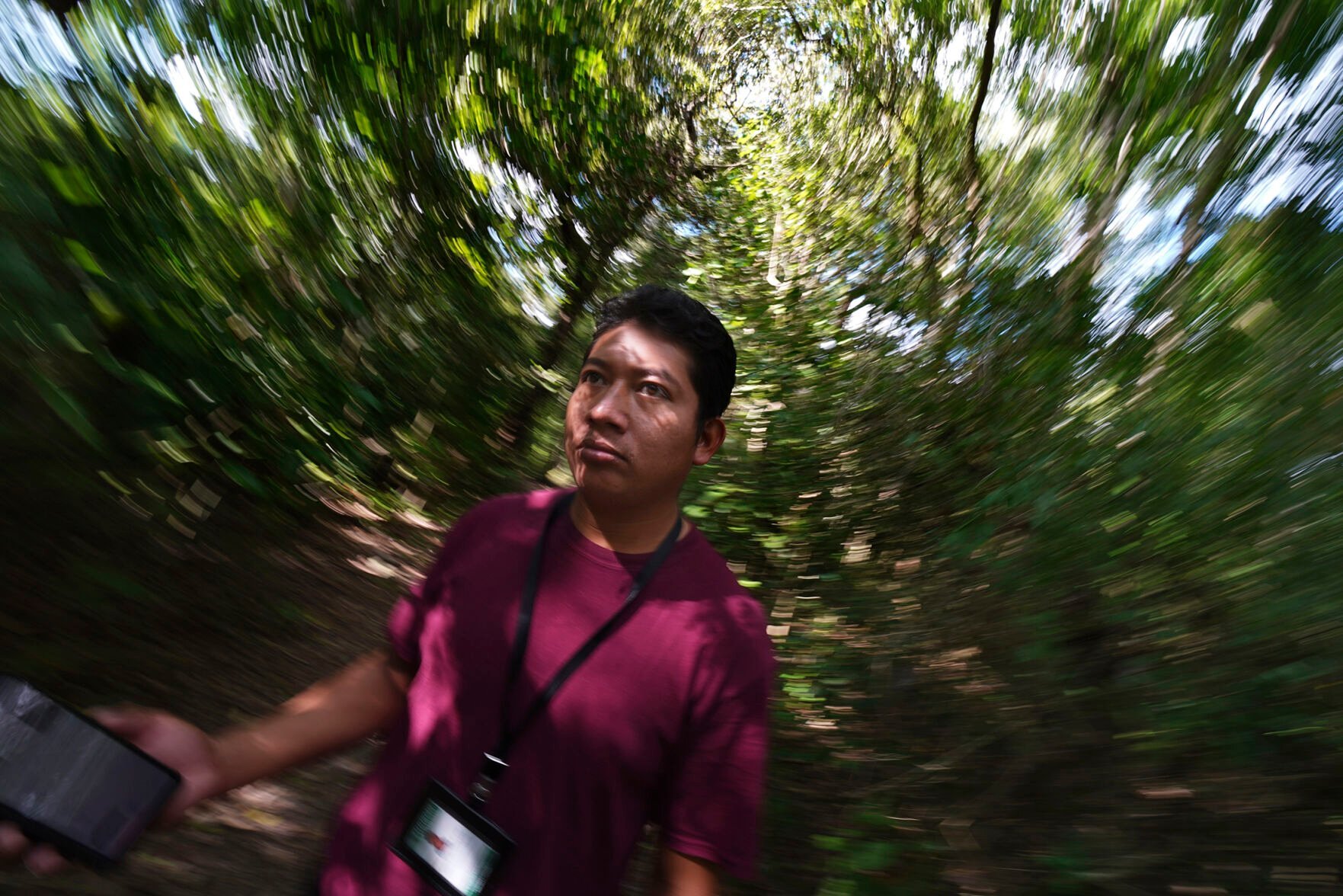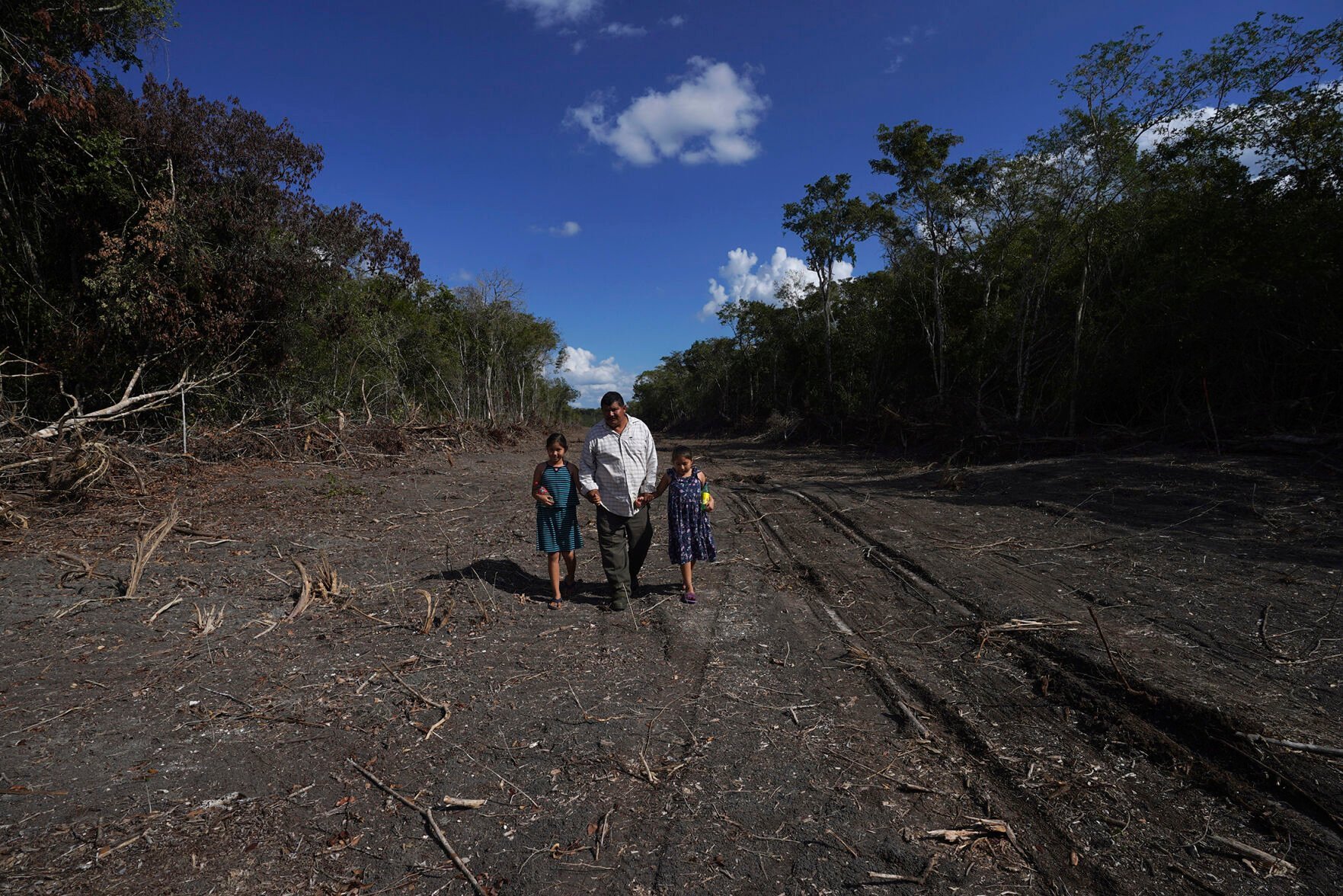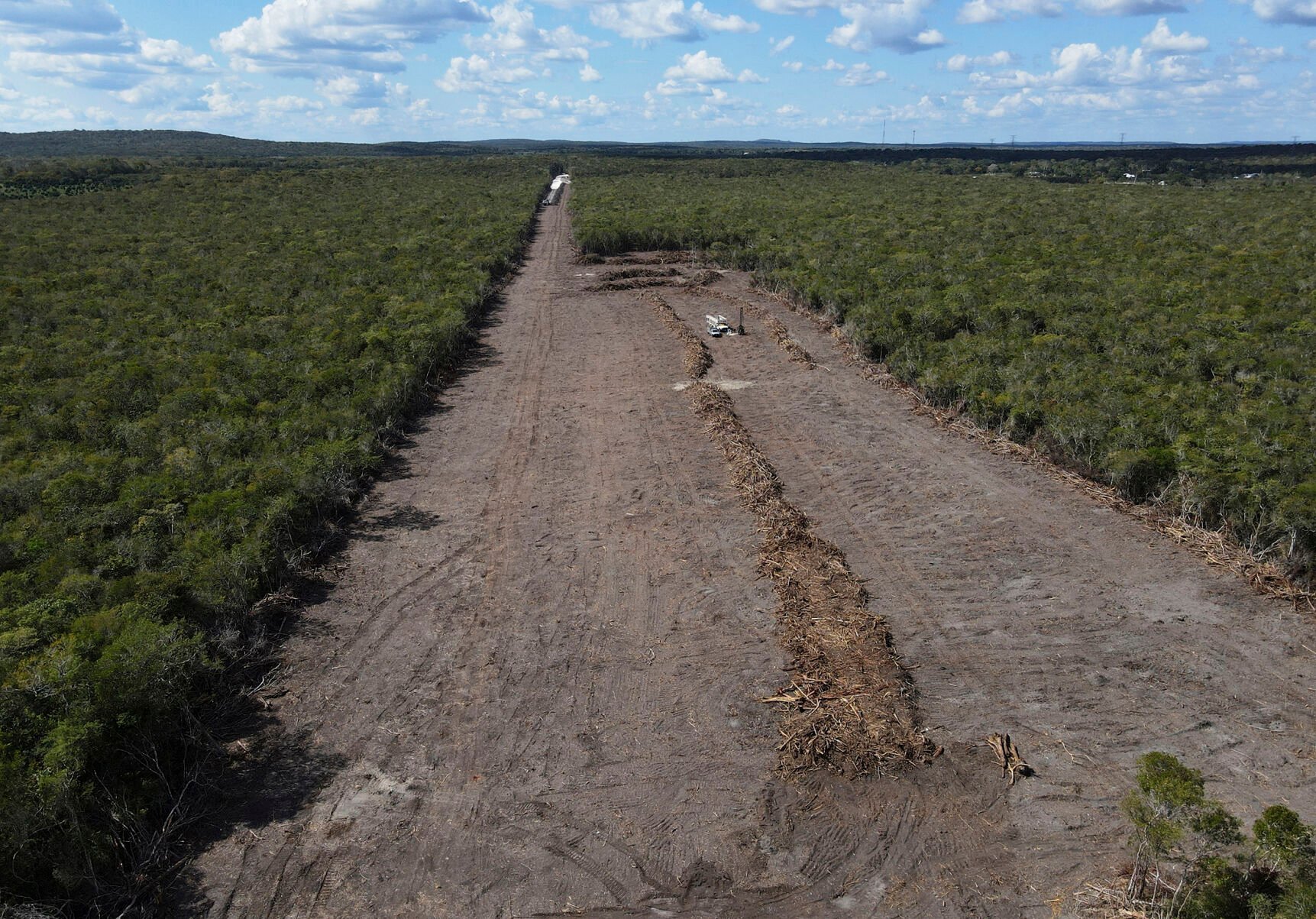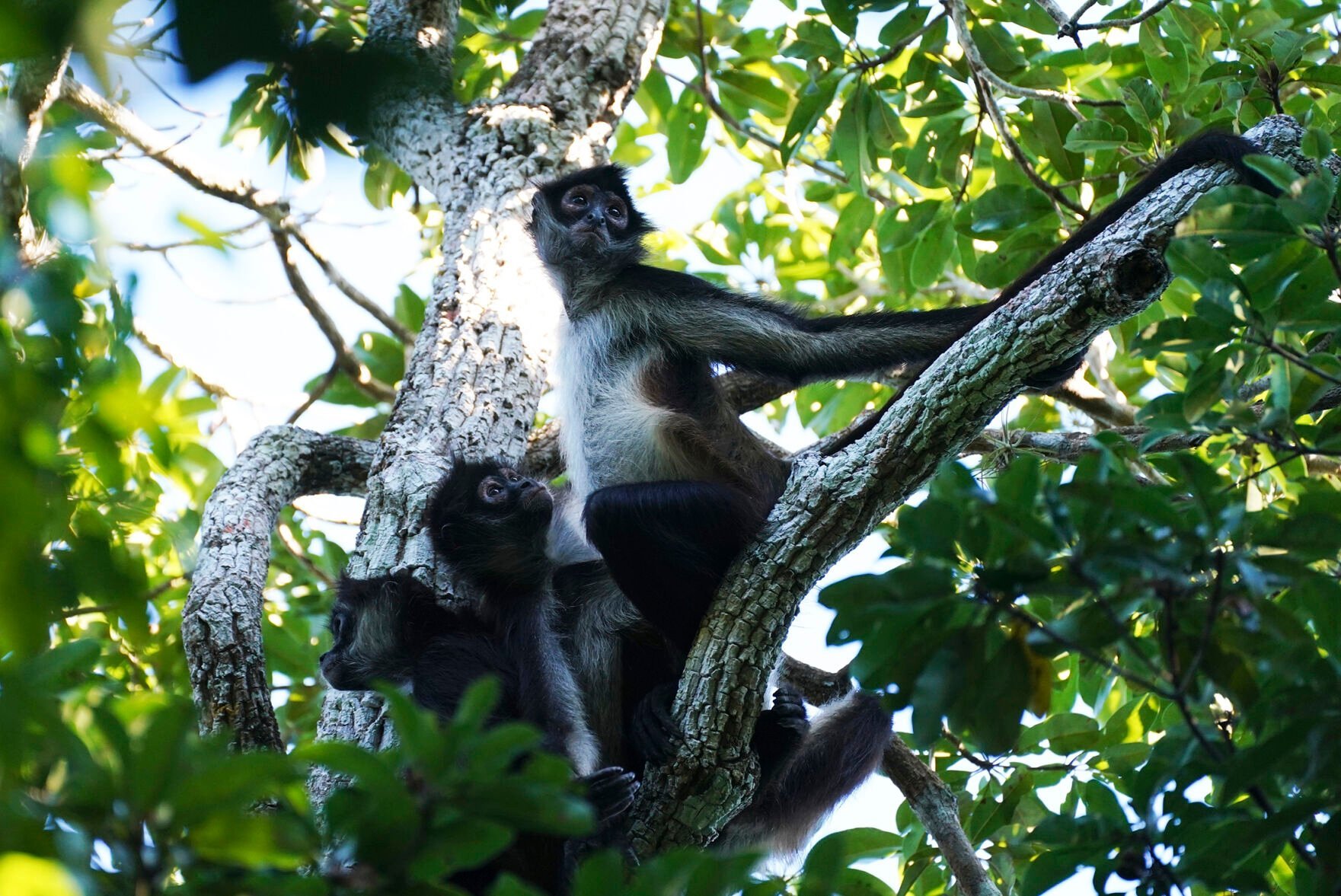CALAKMUL BIOSPHERE RESERVE, Mexico — Miguel Ángel Díaz walks slowly so his footfall on dry leaves doesn’t drive away what he’s trying to find in this dense forest of seeded breadnut and sapodilla trees.
Coming to a small wetland, a sign warns: Beware of the crocodile.
Díaz, a tourist guide, shines a laser pointer at a woodpecker and a toucan, and then moves it over to the blue tail of a Yucatecan jay. He learned years ago to decipher the sounds of the Calakmul jungle in Mexico’s southern Yucatan.

Marco Ugarte, Associated Press
Tour guide Miguel Angel Diaz walks through the Calakmul jungle Jan. 11 in the Yucatan Peninsula of Mexico.
Though it’s high season, this recent morning Díaz had a hard time finding tourists to guide. Last year, just over 50,000 visitors came to Calakmul, home to an ancient Mayan city that today is a UNESCO world heritage site.
Díaz knows many more people will soon come.
“There will be more jobs for us guides,” said Díaz, from the shade of a tree full of lianas. “But it’s going to be a heavy blow to nature.”
Some 12 miles from the crocodile wetland, bulldozers are felling the jungle for the Maya Train, a $20 billion project envisioned by Mexican President Andrés Manuel López Obrador.
A path 130 feet wide is making way for the train, and logs are stacked along the narrow road to the hidden archaeological site. From the top of nearly-deserted pyramids, the roar of howler monkeys sounds across a sea of green.
The Maya Train is intended to drive economic development to some of the country’s poorest areas, in part by bringing up to three million tourists each year.

Marco Ugarte, Associated Press
Omar Hernandez walks with his daughters Jan. 11 on land he sold for the construction of a section of the Maya Train near the Calakmul Biosphere Reserve in the Yucatan Peninsula of Mexico.
Fonatur, the national tourism agency, says the train will address a lack of transport infrastructure in the country’s southeast that has meant “not all our tourist destinations have been fully developed.”
There will be 20 stations along the ride, where hotels and commercial markets are planned. It will also be a cargo route for fuel and farm products.
The 930 miles of rail will pass through unique ecosystems, including the limestone formations filled with freshwater known as cenotes along the Mayan Riviera. This raised a wave of criticism and lawsuits last year that got international attention and temporarily halted the work.
The focus shifted to this section that crosses the intact Calakmul jungle, which is part of the larger Mayan jungle, the largest tropical forest in the Americas after the Amazon.
“I’m not against the train, but for a megaproject of this type, planning normally takes more than 10 years,” said British primatologist Kathy Slater, who has been working in Calakmul for a decade with the organization Operation Wallacea. “But this is without planning, it’s crazy, they’re not thinking about the impacts.”

Marco Ugarte, Associated Press
Trees are cleared Jan. 10 for the construction of a section of the Maya Train near the Calakmul Biosphere Reserve in the Yucatan Peninsula of Mexico.
The president wants the train rolling by the end of this year, when his term ends, designating it a matter of “national security” so as to speed up the environmental and public hearing requirements. The army was put in charge of certain sections, including the one that crosses Calakmul.
A regional Indigenous council filed a complaint over lack of proper consultation and a judge agreed, issuing a stop work order that applied to the nearest city, Xpujil.
“They only talked about the benefits of the megaproject, not about the impacts or the damages,” said Jesús León Zapata, a member of the Xpujil Indigenous Council. The United Nations human rights office warned in December that the national security decree threatened the rights of Indigenous peoples.
The president said several times the national security designation legally allows the work to continue.
“They haven’t complied with court orders,” said Gustavo Alanís, executive director of the Mexico Environmental Law Center. “It’s a serious thing.”
The train’s path crosses the property of Norma Rosado. From her house with wooden planks and a tin roof, she said the government paid her the equivalent of $5,800. Officials also promised to improve the roads and, most important to her, to repair the water main, which only delivers water a few hours two days a week, leaving Rosado and her husband to collect as much as they can in an array of tanks on the patio.

Marco Ugarte, Associated Press
Spider monkeys sit in a tree Jan. 10 in the Calakmul Biosphere Reserve in the Yucatan Peninsula of Mexico.
The area has always been forgotten, said Omar Hernández, Norma’s husband, “and from that point of view whatever they give us is significant. But these benefits are small scale because we’re just farmers, we can’t build hotels. Those will be built by investors.”
Hernández hopes to sell organic honey he produces to tourists. He had to relocate his hives though, worried the heavy machinery would scare them away. Hernández, a big man, looks small as he walks through the new clearcut that runs through their land.
For the biologist Rodrigo Medellín, at Mexico’s largest university, UNAM, the railway simply should not pass through there. “It is going to irreversibly fragment one of the country’s most important strongholds for biodiversity,” he said.
The Calakmul region is home to one of the most important jaguar populations in Mesoamerica, more than 350 species of birds and one hundred mammals, plus other endangered species — the tapir, puma and ocellated turkey.
“I have seen with my own eyes troops of spider monkeys coming through the canopy and suddenly reach the clearcut and there is no way for them to cross,” he said.
-
Worries abound that Mexico’s Maya Train will destroy jungle
Marco Ugarte
Omar Hernandez walks with his daughters on land he sold for the construction of a section of the Maya Train, near the Calakmul Biosphere Reserve in the Yucatan Peninsula of Mexico on Wednesday, Jan. 11, 2023. Hernandez hopes to sell organic honey he produces to tourists. He had to relocate his hives though, worried the heavy machinery would scare them away. (AP Photo/Marco Ugarte)
Marco Ugarte
Omar Hernandez walks with his daughters on land he sold for the construction of a section of the Maya Train, near the Calakmul Biosphere Reserve in the Yucatan Peninsula of Mexico on Wednesday, Jan. 11, 2023. Hernandez hopes to sell organic honey he produces to tourists. He had to relocate his hives though, worried the heavy machinery would scare them away. (AP Photo/Marco Ugarte)
-
Worries abound that Mexico’s Maya Train will destroy jungle
Marco Ugarte
A woman climbs up a pyramid in the Calakmul Biosphere Reserve at the Calakmul Mayan ruins in the Yucatan Peninsula of Mexico on Tuesday, Jan. 10, 2023. The Maya Train, which will stop nearby, is intended to drive economic development to some of the country's poorest areas, in part by bringing up to three million tourists each year. (AP Photo/Marco Ugarte)
Marco Ugarte
A woman climbs up a pyramid in the Calakmul Biosphere Reserve at the Calakmul Mayan ruins in the Yucatan Peninsula of Mexico on Tuesday, Jan. 10, 2023. The Maya Train, which will stop nearby, is intended to drive economic development to some of the country's poorest areas, in part by bringing up to three million tourists each year. (AP Photo/Marco Ugarte)
-
-
Worries abound that Mexico’s Maya Train will destroy jungle
Marco Ugarte
Vehicles traverse a road that includes a sign for the Maya Train and animal crossings in Xpujil, Mexico on Tuesday, Jan. 10, 2023. The Maya Train is intended to drive economic development to some of the country's poorest areas, in part by bringing up to three million tourists each year. (AP Photo/Marco Ugarte)
Marco Ugarte
Vehicles traverse a road that includes a sign for the Maya Train and animal crossings in Xpujil, Mexico on Tuesday, Jan. 10, 2023. The Maya Train is intended to drive economic development to some of the country's poorest areas, in part by bringing up to three million tourists each year. (AP Photo/Marco Ugarte)
-
Worries abound that Mexico’s Maya Train will destroy jungle
Marco Ugarte
Miguel Angel Diaz, a tour guide, walks through the Calakmul jungle in the Yucatan Peninsula of Mexico, Wednesday, Jan. 11, 2023. The Maya Train, which will stop nearby, is intended to drive economic development to some of the country's poorest areas, in part by bringing up to three million tourists each year. “There will be more jobs for us guides,” said Diaz. “But it’s going to be a heavy blow to nature.” (AP Photo/Marco Ugarte)
Marco Ugarte
Miguel Angel Diaz, a tour guide, walks through the Calakmul jungle in the Yucatan Peninsula of Mexico, Wednesday, Jan. 11, 2023. The Maya Train, which will stop nearby, is intended to drive economic development to some of the country's poorest areas, in part by bringing up to three million tourists each year. “There will be more jobs for us guides,” said Diaz. “But it’s going to be a heavy blow to nature.” (AP Photo/Marco Ugarte)
-
-
Worries abound that Mexico’s Maya Train will destroy jungle
Marco Ugarte
Trees have been cleared for the construction of a section of the Maya Train near the Calakmul Biosphere Reserve in the Yucatan Peninsula of Mexico, Tuesday, Jan. 10, 2023. The Maya Train is intended to drive economic development to some of the country's poorest areas, in part by bringing up to three million tourists each year. (AP Photo/Marco Ugarte)
Marco Ugarte
Trees have been cleared for the construction of a section of the Maya Train near the Calakmul Biosphere Reserve in the Yucatan Peninsula of Mexico, Tuesday, Jan. 10, 2023. The Maya Train is intended to drive economic development to some of the country's poorest areas, in part by bringing up to three million tourists each year. (AP Photo/Marco Ugarte)
-
Worries abound that Mexico’s Maya Train will destroy jungle
Marco Ugarte
Cars on a road near Xpujil, Mexico, can be seen through pipes to restore the local water main on Wednesday, Jan. 11, 2023. A major rail project in the Yucatan Peninsula, called the Maya Train, is intended to drive economic development to some of the country’s poorest areas, in part by bringing up to three million tourists each year. (AP Photo/Marco Ugarte)
Marco Ugarte
Cars on a road near Xpujil, Mexico, can be seen through pipes to restore the local water main on Wednesday, Jan. 11, 2023. A major rail project in the Yucatan Peninsula, called the Maya Train, is intended to drive economic development to some of the country’s poorest areas, in part by bringing up to three million tourists each year. (AP Photo/Marco Ugarte)
-
-
Worries abound that Mexico’s Maya Train will destroy jungle
Marco Ugarte
A baby crocodile is visible in waters of the Calakmul Biosphere Reserve in the Yucatan Peninsula of Mexico on Wednesday, Jan. 11, 2023. Not too far from the crocodile wetland, bulldozers are felling the jungle for the Maya Train, a $20 billion dollar project envisioned by Mexican President Andrés Manuel López Obrador. (AP Photo/Marco Ugarte)
Marco Ugarte
A baby crocodile is visible in waters of the Calakmul Biosphere Reserve in the Yucatan Peninsula of Mexico on Wednesday, Jan. 11, 2023. Not too far from the crocodile wetland, bulldozers are felling the jungle for the Maya Train, a $20 billion dollar project envisioned by Mexican President Andrés Manuel López Obrador. (AP Photo/Marco Ugarte)
-
Worries abound that Mexico’s Maya Train will destroy jungle
Marco Ugarte
Spider monkeys sit in a tree in the Calakmul Biosphere Reserve in the Yucatan Peninsula of Mexico on Tuesday, Jan. 10, 2023. The Calakmul region is home to one of the most important jaguar populations in Mesoamerica, more than 350 species of birds and one hundred mammals, plus other endangered species — the tapir, puma and ocellated turkey. (AP Photo/Marco Ugarte)
Marco Ugarte
Spider monkeys sit in a tree in the Calakmul Biosphere Reserve in the Yucatan Peninsula of Mexico on Tuesday, Jan. 10, 2023. The Calakmul region is home to one of the most important jaguar populations in Mesoamerica, more than 350 species of birds and one hundred mammals, plus other endangered species — the tapir, puma and ocellated turkey. (AP Photo/Marco Ugarte)
-
-
Worries abound that Mexico’s Maya Train will destroy jungle
Marco Ugarte
Tourists walk near a sign that reads ‘beware of the crocodile’ in the Calakmul Biosphere Reserve in the Yucatan Peninsula of Mexico on Wednesday, Jan. 11, 2023. Not too far from the crocodile wetland, bulldozers are felling the jungle for the Maya Train, a $20 billion dollar project envisioned by Mexican President Andrés Manuel López Obrador. (AP Photo/Marco Ugarte)
Marco Ugarte
Tourists walk near a sign that reads ‘beware of the crocodile’ in the Calakmul Biosphere Reserve in the Yucatan Peninsula of Mexico on Wednesday, Jan. 11, 2023. Not too far from the crocodile wetland, bulldozers are felling the jungle for the Maya Train, a $20 billion dollar project envisioned by Mexican President Andrés Manuel López Obrador. (AP Photo/Marco Ugarte)
-
Worries abound that Mexico’s Maya Train will destroy jungle
Marco Ugarte
Trees have been cleared for a section of the Maya Train in Xpujil, Mexico, Tuesday, Jan. 10, 2023. The Maya Train is intended to drive economic development to some of the country's poorest areas, in part by bringing up to three million tourists each year. (AP Photo/Marco Ugarte)
Marco Ugarte
Trees have been cleared for a section of the Maya Train in Xpujil, Mexico, Tuesday, Jan. 10, 2023. The Maya Train is intended to drive economic development to some of the country's poorest areas, in part by bringing up to three million tourists each year. (AP Photo/Marco Ugarte)
-
-
Worries abound that Mexico’s Maya Train will destroy jungle
Marco Ugarte
Wild turkeys walk in the Calakmul Biosphere Reserve in the Yucatan Peninsula of Mexico on Tuesday, Jan. 10, 2023. The Calakmul region is home to one of the most important jaguar populations in Mesoamerica, more than 350 species of birds and one hundred mammals, plus other endangered species — the tapir, puma and ocellated turkey. (AP Photo/Marco Ugarte)
Marco Ugarte
Wild turkeys walk in the Calakmul Biosphere Reserve in the Yucatan Peninsula of Mexico on Tuesday, Jan. 10, 2023. The Calakmul region is home to one of the most important jaguar populations in Mesoamerica, more than 350 species of birds and one hundred mammals, plus other endangered species — the tapir, puma and ocellated turkey. (AP Photo/Marco Ugarte)
-
Worries abound that Mexico’s Maya Train will destroy jungle
Marco Ugarte
Bats come out of the Volcan de los Murcielagos, a cave that is home to three million bats, in the Balam-Ku reserve, in the Yucatan Peninsula of Mexico on Wednesday, Jan. 11, 2023. One version of the Maya Train plan had the tracks passing less than a half mile from the bat cave. (AP Photo/Marco Ugarte)
Marco Ugarte
Bats come out of the Volcan de los Murcielagos, a cave that is home to three million bats, in the Balam-Ku reserve, in the Yucatan Peninsula of Mexico on Wednesday, Jan. 11, 2023. One version of the Maya Train plan had the tracks passing less than a half mile from the bat cave. (AP Photo/Marco Ugarte)
-
-
Worries abound that Mexico’s Maya Train will destroy jungle
Marco Ugarte
Bees from Omar Hernandez’s hives fly near what will be a section of the Maya Train near the Calakmul Biosphere Reserve in the Yucatan Peninsula of Mexico, Wednesday, Jan. 11, 2023. Hernandez hopes to sell organic honey he produces to tourists. He had to relocate his hives though, worried the heavy machinery would scare them away. (AP Photo/Marco Ugarte)
Marco Ugarte
Bees from Omar Hernandez’s hives fly near what will be a section of the Maya Train near the Calakmul Biosphere Reserve in the Yucatan Peninsula of Mexico, Wednesday, Jan. 11, 2023. Hernandez hopes to sell organic honey he produces to tourists. He had to relocate his hives though, worried the heavy machinery would scare them away. (AP Photo/Marco Ugarte)
-
Worries abound that Mexico’s Maya Train will destroy jungle
Marco Ugarte
A woodpecker hangs on to a tree in the Calakmul Biosphere Reserve in the Yucatan Peninsula of Mexico on Wednesday, Jan. 11, 2023. The Calakmul region is home to one of the most important jaguar populations in Mesoamerica, more than 350 species of birds and one hundred mammals, plus other endangered species — the tapir, puma and ocellated turkey. (AP Photo/Marco Ugarte)
Marco Ugarte
A woodpecker hangs on to a tree in the Calakmul Biosphere Reserve in the Yucatan Peninsula of Mexico on Wednesday, Jan. 11, 2023. The Calakmul region is home to one of the most important jaguar populations in Mesoamerica, more than 350 species of birds and one hundred mammals, plus other endangered species — the tapir, puma and ocellated turkey. (AP Photo/Marco Ugarte)
-
-
Worries abound that Mexico’s Maya Train will destroy jungle
Marco Ugarte
Omar Hernandez shows honey at a beehive near the Calakmul Biosphere Reserve in the Yucatan Peninsula of Mexico on Wednesday, Jan. 11, 2023. Hernandez hopes to sell organic honey he produces to tourists. He had to relocate his hives though, worried the heavy machinery would scare them away. (AP Photo/Marco Ugarte)
Marco Ugarte
Omar Hernandez shows honey at a beehive near the Calakmul Biosphere Reserve in the Yucatan Peninsula of Mexico on Wednesday, Jan. 11, 2023. Hernandez hopes to sell organic honey he produces to tourists. He had to relocate his hives though, worried the heavy machinery would scare them away. (AP Photo/Marco Ugarte)
-
Worries abound that Mexico’s Maya Train will destroy jungle
Marco Ugarte
Bats come out of the Volcan de los Murcielagos, a cave that is home to three million bats, in the Balam-Ku reserve, in the Yucatan Peninsula of Mexico, on Wednesday, Jan. 11, 2023. One version of the Maya Train plan had the tracks passing less than a half mile from the bat cave. (AP Photo/Marco Ugarte)
Marco Ugarte
Bats come out of the Volcan de los Murcielagos, a cave that is home to three million bats, in the Balam-Ku reserve, in the Yucatan Peninsula of Mexico, on Wednesday, Jan. 11, 2023. One version of the Maya Train plan had the tracks passing less than a half mile from the bat cave. (AP Photo/Marco Ugarte)
-
-
Worries abound that Mexico’s Maya Train will destroy jungle
Marco Ugarte
Two people row on a lake in the Valentin Gomez Farias communal farmlands near the Calakmul Biosphere Reserve in the Yucatan Peninsula of Mexico on Wednesday, Jan. 11, 2023. Residents created an ecotourism project nine years ago that has visitors staying in tents under roofs of woven palm. (AP Photo/Marco Ugarte)
Marco Ugarte
Two people row on a lake in the Valentin Gomez Farias communal farmlands near the Calakmul Biosphere Reserve in the Yucatan Peninsula of Mexico on Wednesday, Jan. 11, 2023. Residents created an ecotourism project nine years ago that has visitors staying in tents under roofs of woven palm. (AP Photo/Marco Ugarte)




